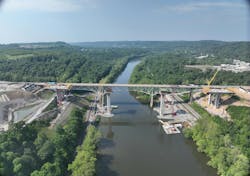Modernizing the Pennsylvania Turnpike’s Beaver River Bridge
Key Takeaways
- The Beaver River Bridge project replaces the aging steel truss with dual cast-in-place segmental bridges, improving traffic flow and supporting commercial trucks.
- Crews use a balanced cantilever construction method with form travelers, allowing precise and efficient assembly of each bridge segment.
- The project demonstrates large-scale material use and collaboration, delivering modern, durable infrastructure that meets regional transportation needs.
By Hazel Modlin, Contributing Author
Fay, S&B USA Construction (Fay) began work as a partner on the Pennsylvania Turnpike’s Beaver River Bridge project in December 2022. Currently, it represents the largest contract in Pennsylvania Turnpike Commission history.
The goal of this project is to efficiently replace a steel truss bridge with two modern, cast-in-place segmental bridge structures to carry motorists and commercial trucks over the Beaver River and CSX and Norfolk Southern railroad lines.
The total project area covers around 260 acres, where it will construct five total bridges, install precast culvert extensions, reconfigure an interchange to a half cloverleaf/half diamond ramp system, and widen two miles of roadway.
The centerpieces of this project are the dual cast-in-place segmental bridges. This year, the Beaver River Bridge reached a significant milestone: the form travelers were installed in February, marking the official start of the segmental portion of construction. Fay leased these pieces of equipment from Schwager Davis Inc. and shipped them in from Wisconsin.
“They had previously been used on another Turnpike project: the Mon-Fayette (Expressway) Bridge,” Project Engineer Jason Komar said.
Crews assembled what they could on the ground, then the 300,000-pound form travelers were lifted into place using Kobelco 2750 and Manitowoc 999 cranes.
Fay has a total of four active form travelers.
“It takes about two weeks to cast one segment,” Komar said. “We’re working on four segments at any given time.”
The form travelers work in pairs. Starting on the table of each pier, the form travelers help Fay pour the deck of the bridge in 15-foot segments, following a pattern of one segment up station, countered with one down station. This will prevent the bridge from becoming unbalanced.
Fay has finished the first two cantilevers, and the form travelers will soon be transferred to two other piers on the westbound bridge.
In total, Fay will be casting 176 individual segments to create both bridges. While the majority of segments will have the same width and length, the height of each varies, which can be adjusted by raising the bottom platform up using high stress post tension rods. The eastbound Span 1 varies in width to accommodate an on ramp.
The process of constructing a bridge using the balanced cantilever method is quite different than traditional bridge-building.
“The only similarity is the substructure,” Project Engineer Austin Uric said. “The superstructure is completely different.”
Once a segment has been poured, the form traveler is launched using mechanical rollers and hydraulic jacks.
“The exterior form launches first,” Uric said. “This allows us to install the rebar for the bottom slab and the walls. Then, the interior formwork is launched, and the rebar for the top slab is installed.”
After all the rebar has been installed, crews install post tensioning ducts and strands and pour the segment. The concrete is left to cure. Once the desired strength has been achieved, crews then strip bulkhead formwork, post tension the segment, and get ready for the next launch.
Segmental bridges are relatively uncommon in this area, with only the Turnpike’s Allegheny River Bridge in Harmarville and the Mon-Fayette Expressway Bridge in Denbo nearby. This makes the Beaver River Bridge a notable addition to the region’s infrastructure.
The materials alone reflect the scale of the structure: enough concrete—50,000 cubic yards—to fill over 16 Olympic-sized swimming pools, and steel strand that, if stretched end to end, would span nearly 412 miles—from Pittsburgh to Chicago.
Beyond the numbers, the Beaver River Bridge showcases how collaboration can strengthen local delivery and produce quality infrastructure that meets regional needs with added depth of experience.
Hazel Modlin earned a bachelor's in English literature from Edinboro University in 2022. She currently works as a Marketing Writer for S&B USA, a company that specializes in developing and constructing complex infrastructure projects that transform and enhance communities.
